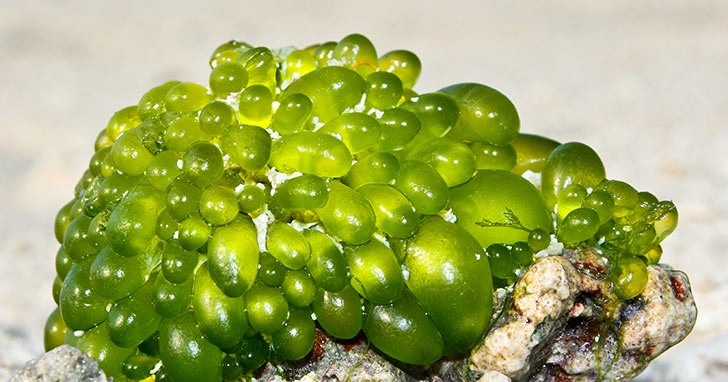
Algae Identification in Saltwater Tanks and Proper RemovalWhat is algae and why is it a problem in aquariums?
Owners of both freshwater aquariums and marine aquariums are concerned with algae. Algae has been around for billions of years, and new strains are still being discovered. It is estimated there may be over 37,000 species. Thankfully, not all these species grow in tanks, and some algae in small amounts are not a problem in aquariums. Macroalgae is a form of good algae and can actually keep the bad algae at bay since they both require the same nutrients to grow. Since macro algae outcompetes nuisance algae for nutrients, some hobbyists encourage the growth of macro algae so there are less nuisance algae. But even good algae need to be monitored because it can ruin tanks if left unchecked. In addition to being unsightly, bad algae can create toxic byproducts that are detrimental to fish and corals. Bryopsis Algae
Bryopsis Algae typically grow on rocks and are a little harder to identify because in their early growth stages they look like green colored hair algae but as they mature, they take on more of a fern shape. How do you prevent Bryopsis Algae? To help prevent these algae, you can reduce the level of nitrates and phosphates in your water, reduce the amount of light in your aquarium and increase water flow. You could also try to eliminate them by dosing your aquarium and increasing water flow. You could also try to eliminate them by dosing your aquarium with a reef buffer to increase the magnesium level. Be sure to dose carefully and test your parameters often, to avoid spiking levels that may shock your aquarium. Caulerpa Algae
Caulerpa Algae is green and has a main stem from which it sends out runners. Feather-like growths form on these runners. They are common hitchhikers on live rock and coral. How do you prevent Caulerpa Algae? This algae is pervasive, so it is best to concentrate your efforts on never having this algae invade your marine aquarium at all. What you can do to this end is to have a regular maintenance schedule for your tank. If you do have an invasion, you could also try to employ the use of aquatic life that may eat this type of algae, such as Lettuce Sea Slug, Seahare, Rabbitfish, or herbivorous Tangs. Manual removal and sterilization of infected areas is also a possible solution. Cyanobacteria (Red Slime Algae)
Cyanobacteria is a slimy bacterium that creates nitrogen that can actually boost the growth of other algae, so its presence is detrimental to the health of your tank. It will smother and kill coral and beneficial bacteria in the sand bed. How do you prevent Cyanobacteria (Red Slime Algae)? You can remove this algae manually or use a siphon on your sand bed or a fish net to scoop it out of your sand. There are also chemical removers and conditioners that can be used as long as you select one that is safe for your aquatic life. The bacterial treatment Erythromycin can be used to control this algae, however, care must be taken when using this product as it may also kill beneficial bacteria in the aquarium. Diatoms (Bacillariophyta/Brown Algae)
Generally speaking, Diatoms or brown algae are one of the few algae that are good for your aquarium because they produce oxygen. How do you prevent Diatoms (Bacillariophyta/Brown Algae)? Limit the nutrients in your saltwater aquarium. You may also add grazing snails such as Turbo, Astraea, and Trochus. Fish such as Blennies and Bristletooth Tang will also graze on brown algae. Dinoflagellates
This algae is more difficult to identify, as it can be colorless or come in shades of light green to dark brown. It is important to identify them, however, as they are extremely toxic and deadly to low lying snails and harmful to your tank. Most often they present themselves in your tank as brown bubbly slime that produces air bubbles. How do you prevent Dinoflagellates? Dinoflagellates are notoriously difficult to get rid of because they thrive in nutrient starved environments. If you do end up with Dinoflagellates, try removing them with a micron filter and skimmer. If compatible with your aquatic life, you can try to rid your tank of Dinoflagellates by increasing nitrates and phosphates and removing nutrient reducing media. A pH level of 8.4 can keep this algae from blooming. Reducing the light in your tank, introducing carbon, and employing a UV sterilizer might all prove beneficial in fighting this algae also. Green Algae (Hair Algae)
Green Hair Algae looks like its name describes. You can identify this algae because it looks like hair strands on the edges of décor and rocks or a clump of hair that looks matted together. How do you prevent Green Algae (Hair Algae)? Manually remove as much algae as you can, increase your tank water changes to twice a week, and keep fish feeding to a level that eliminates extra food in the aquarium. The addition of algae eating animals such as snails, hermit crabs, urchins, blennies, tangs & rabbitfish may help curb additional growth. Valonia (Bubble Algae)
Bubble Algae are green spheres that contain thousands of spores. A common hitchhiker on live rock and coral, this algae most commonly grows in clumps. How do you prevent Valonia (Bubble Algae)? Manually remove them taking care not to pierce the bubble because the spores will release into the tank. Follow up with sterilization of affected areas. In Conclusion
When you maintain a marine tank, you may experience the presence of algae at one time or another. Do not let this deter you from fishkeeping, as there are many ways to address algae removal. There are also maintenance and stock feeding routines you can implement so the conditions are not present that enable algae to grow. Related Articles
|
|
|


